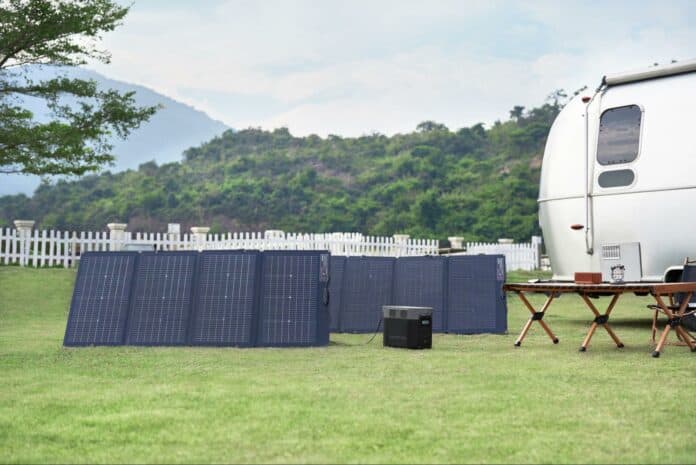As solar technology becomes more widely adopted, manufacturers are continuing to improve the technology and drive prices down.
Solar panel efficiencies are reaching record highs, allowing panels to produce more electricity in the same amount of space.
Solar panel efficiency refers to how well a solar panel can convert sunlight into usable electricity. Depending on the type of solar cells used, the efficiency of consumer solar panels ranges anywhere from about 8% for thin film photovoltaic to 23% for monocrystalline silicon.
Numerous factors can impact solar panel efficiency, including the type of solar cells, the quality of materials and construction, the panel’s placement and age, and environmental conditions like temperature.
Before we dive in, it’s essential to understand that “efficiency” has a very specific meaning as a specification for solar panels.
Solar panel efficiency measures the percentage of direct sunlight shining on the panel’s photovoltaic surface that gets converted into electricity.
In practice, the higher a solar panel’s efficiency, the more electricity you can generate with the same amount of space and sunlight.
For example, a rigid solar panel with 400W of rated power and 23% efficiency can produce 400wH of electricity under ideal conditions. A rigid solar panel with 400W of rated power and an efficiency rating of 18% will require a significantly larger surface area to generate the same amount of electricity.
With that in mind, let’s look at the five most efficient solar panels in 2023.
EcoFlow’s Top Solar Panels for Efficiency
Best for Hiking/Backpacking – 160W Portable Solar Panel
Best for Car Camping – 220W Bifacial Portable Solar Panel
Best for Extended Off-Grid Adventures – 400W Portable Solar Panel
Best for Permanent Installations – 400W Rigid Solar Panel
Best for Maximizing Available Surface Area – 100W Flexible Solar Panel
1. 160W Portable Solar Panel – Best for Hiking/Backpacking
The EcoFlow 160W Portable Solar Panel provides an excellent combination of efficiency and portability. One of the smallest and lightest-weight portable solar panels available, it still boasts an impressive 160W of rated power output.
The EcoFlow 160W panel comes with a carrying case that serves a dual purpose: protection and support. Unfold the case, and it becomes a sturdy kickstand, allowing you to adjust the panel for optimal solar charging.
The panel features monocrystalline silicon solar cells and a high 21-22% efficiency rating.
The 160W panel can keep collecting energy even during adverse weather conditions. Thanks to a protective ETFE film and a high IP68 rating, the solar cells can operate efficiently and safely in a wide range of environments.
The one-piece foldable design makes it easy to set up and pack away, ensuring you can harness the sun’s energy wherever you go.
Specifications
Efficiency: 21–22%
Rated Power: 160W (±5W)
Solar Cell Type: Monocrystalline
Waterproof Rating: IP68
Weight: 15.4 lb (Approx. 7 kg) with Kickstand Case
Unfolded Dimensions: 26.8 × 61.8 × 1.0 in (68 × 157 × 2.4 cm)
Folded Dimensions: 26.8 × 16.5 × 1.0 in (68 × 42 × 2.4 cm)
Pros
- Portability: Weighing only 15.4 lbs (7kg) and featuring a self-supporting design, this panel is easy to carry and set up.
- High Conversion Efficiency: With a 21-22% conversion rate, this panel harnesses the sun’s power much more efficiently than other portable PV panels on the market.
- Durable and Weather Resistant: The panel can operate in extreme weather conditions thanks to the protective ETFE film and an IP68 rating. It can even be immersed in water!
- Universal: Compatible with a wide range of portable power stations and solar generators from manufacturers other than EcoFlow
- Easy to Use: The panel’s one-piece folding design makes it straightforward to set up and use.
Cons
- Low Rated Power Output: At 160W, the power output is lower than other panels on this list. Depending on your power needs, this might not be sufficient.
2. 220W Bifacial Portable Solar Panel – Best for Car Camping
The EcoFlow 220W Bifacial Portable Solar Panel redefines the power potential of portable panels. This model features 220W of output on the primary side, complemented by a 155W side at the back for ambient light capture.
Though not designed for backpacking, this panel is incredibly compact and space-efficient. You can easily store it in vehicles, motorhomes, cabins, and tiny homes.
Like the other EcoFlow panels, this 220W version maintains the IP68 rating, meaning it’s designed to withstand extreme weather conditions. Along with the PV panel, you receive a kickstand case that offers protection during storage while also serving as a stand to position your panel for maximum sun exposure throughout the day.
This panel is ideal for car camping, motorhome excursions, and other off-grid settings. If your electricity demand surpasses the panel’s 220W limit, connecting multiple panels is possible. Just make sure not to exceed your portable power station’s solar input/charging capacity.
For many applications, a single 220W bifacial solar panel’s output is more than sufficient.
The bifacial panel also has an impressive lifespan that promises less than 10% power degradation over a decade.
Specifications
Efficiency: 22–23%
Rated Power: 220W Front Side / 155W Rear Side
Cell Type: Monocrystalline
Waterproof Rating: IP68
Weight: Approx. 20.9 lbs (around 9.5 kg)
Dimensions: 32.3 × 72.0 × 1.0 in (82 × 183 × 2.5 cm)
Pros
- Bifacial Design: The panel’s dual-sided design enables it to collect up to 25% more solar energy, thus recharging your portable power station more quickly.
- Durability: The tempered glass is robust and resistant to high and low temperatures, ensuring the panel can withstand extreme conditions.
- Portability: Despite its high power output, the panel is designed to be compact, easy to carry, and comes with its own carrying case that doubles as a kickstand.
- High Efficiency: With a conversion rate of up to 23%, this panel ensures optimal use of available sunlight.
- Waterproof: The IP68 rating indicates that the panel can withstand extreme weather conditions, making it ideal for outdoor use.
Cons
- Weight: At over 20 lbs, this model may be a bit heavy to carry around for extended periods.
3. 400W Portable Solar Panel – Best for Extended Off-Grid Adventures
The EcoFlow Portable Solar Panel has the highest rated power output of all the portable solar panels on this list. With a whopping 400 watts of rated power, this panel can keep your essential devices and camping appliances charged and running indefinitely.
This panel is too big for backpackers, but it folds down and slides away for easy storage in cars, motorhomes, cabins, and tiny homes.
Like EcoFlow’s other panels, this 400W model features an IP68 waterproof rating to withstand the harsh weather of your wildest adventures. The kickstand case protects the panel from damage while stored away.
The case also serves as a stand that lets you orient your panel for maximum direct sunlight capture throughout the day.
The 400W Portable Solar Panel is perfect for boondocking, car camping, motorhome trips, and other off-grid applications. If you need more than 400 watts of rated power, you’ll need to connect multiple panels together.
Remember to check the maximum solar input of your portable power station. For example, DELTA Pro can support 4 x 400W PV panels or eight if you chain two DELTA Pros together using the Double Voltage Hub.
EcoFlow’s Power Kits can support up to 12 x 400W solar panels for full-time motorhome or tiny home living.
Specifications
Efficiency: 22.40%
Rated Power: 400W
Cell Type: Monocrystalline
Waterproof Rating: IP68
Weight: Approx 35.3 lbs (16.0 kg) / Approx. 41.9 lbs (19.0 kg) with Kickstand Case
Dimensions: 42.0 × 94.1 × 1.0 in (106.8 × 239.0 × 2.4 cm)
Pros
- High Output: 400 watts is the highest available rated power output from an EcoFlow portable solar panel.
- Adjustable Angle: The kickstand case can provide different tilt angles for your panel, allowing you to optimise sun exposure throughout the day.
- Water Resistance: The IP68 rating ensures this panel can withstand rain and other harsh weather conditions.
- Plug-n-Play: Fully compatible with EcoFlow’s portable power stations. Chain up to 12 400W PV panels with a Power Kit.
Cons
- Not for Hikes or Long Treks: The large size isn’t ideal for hiking or backpacking. Purchase a smaller model if you need to carry the panel for extended distances.
4. 400W Rigid Solar Panel – Best for Permanent Installations
The EcoFlow 400W Rigid Solar Panel is ideal for permanent installations, including residential and motorhome applications. EcoFlow’s rigid solar panels offer an industry-leading efficiency rating of 23%, generating more electricity with less surface area than less efficient rigid solar panels.
Built to last, it features a durable anti-corrosive aluminium frame and boasts an IP68 waterproof rating, making it suitable for long-term outdoor installation even in extreme weather conditions.
It can withstand wind speeds up to 130 mph and blizzards. Exception durability ensures this rigid solar panel will continue capturing solar energy for decades to come, yielding an attractive return on investment.
The 400W rigid solar panel works well in both grid-tied and off-grid setups, making it an excellent choice to build out your residential solar array. You can even achieve energy independence with a whole home generator and enough 400W rigid PV panels.
The 400W rigid solar panels also work well with the modular Power Kits popular for motorhomes, tiny homes, and van life. Especially when combined with flexible and portable solar panels to maximise electricity generation potential.
Specifications
Efficiency: 23%
Rated Power: 400W
Cell Type: Monocrystalline
Waterproof Rating: IP68
Weight: Approx. 48.1 lbs (21.8 kg)
Dimensions: 67.8 × 44.6 × 1.38 in (172.2 × 113.4 × 3.5 cm)
Pros
- Industry-Leading Efficiency: With an efficiency rating of 23%, this panel helps maximise available surface area and capture more electricity than most other monocrystalline and all polycrystalline panels of a similar size.
- Durable and Weatherproof: The IP68 waterproof rating and anti-corrosive aluminium frame make this panel capable of withstanding extreme weather conditions, including heavy snow and high wind speeds.
- Versatile Use: It is suitable for both on-grid and off-grid setups, making it ideal for a wide range of residential and motorhome applications.
- Universally Compatible: Thanks to its universal solar connector, you can use this panel with pretty much any modern solar power system — regardless of manufacturer.
Cons
- Heavy: With a net weight of 48.1 lbs (21.8kg), the panel can be challenging to install and manoeuvre alone. For rooftop installations, consider working with a reputable installation professional.
5. 100W Flexible Solar Panel – Best for Maximizing Available Surface Area
EcoFlow’s 100W Flexible Solar Panel is the highest efficiency flexible PV panel available.
Most flexible solar panels are made from thin film solar cells — which typically have low efficiency, often in the single digits.
Like all of the PV panels featured in this guide, the ultra-lightweight 100W flexible solar panel is constructed of monocrystalline solar cells, giving it unparalleled efficiency for a panel that can bend up to 258 degrees.
One hundred watts of rated power means it’s unlikely that you’ll want to build your solar panel array out of these alone. This solar panel’s true strength is literally its flexibility. You can maximise your available surface area by mounting flexible solar panels to multiple curved and uneven surfaces. It’s an ideal choice for maximising electricity generation on van rooftops, motorhomes, boats, and other applications where flat exterior space is at a premium.
The solar panel is around 70% lighter than traditional solar panels, making it easy to transport and install. It’s so thin and lightweight that you don’t even have to drill any holes to mount it. You can safely affix this flexible solar panel to almost any surface using silicone-based adhesives like SG20 or Fix8 or double-sided acrylic foam tape like 3M VHB.
With a high solar conversion efficiency of 23%, the 100W Flexible Solar Panel performs at the same rate as its rigid and portable counterparts. The panel’s integrated bypass diodes prevent overheating and maintain cell performance, even in shaded environments.
This flexible panel is rated IP68 for water and dust resistance, meaning it can withstand the harshest weather conditions, from heavy rain to dust storms.
Specifications
Efficiency: 23%
Rated Power: 100W (±5W)
Cell Type: Monocrystalline
Waterproof Rating: IP68
Weight: Approx. 5.1 lbs (around 2.3 kg)
Dimensions: 41.5 × 24.1 × 1.0 in (105.5 × 61.2 × 2.5 cm)
Pros
- Lightweight and flexible: Weighing just 5.1 lbs and flexible up to 258 degrees, this panel can be easily installed on curved or irregular surfaces.
- High efficiency: The monocrystalline cells offer a high efficiency rate of 23%, ensuring fast and efficient charging.
- Durable and weather-resistant: With an IP68 rating, the panel is designed to withstand extreme weather conditions, and the protective ETFE film adds another layer of durability.
- Easy installation: Pre-cut eyelets make installing the panel in your preferred configuration easy. Or skip drilling altogether and affix the flexible panel using adhesive.
- Universal compatibility: The included solar connector and cable make this panel compatible with systems from multiple manufacturers.
Cons
- Low rated power output: This panel’s flexibility and lightweight design are its best features. Its 100W rating means it’s suitable for only low-powered standalone applications. Flexible solar panels are best suited as additions to a more extensive rigid or portable solar panel array.
Why Is Solar Panel Efficiency Important?
Solar panel efficiency is essential because it determines how much electricity a solar panel or array can generate with a specific photovoltaic surface area.
Efficient solar panels may cost more upfront, but they can significantly shorten your solar payback period by generating more electricity.
Over the 25+ year lifespan of a monocrystalline solar panel, you’re almost guaranteed to get a better ROI than with polycrystalline or other currently available solar cell technologies.
Efficiency is paramount if you install your solar array on a roof or other location with limited space that receives direct sunlight (such as a motorhome, camper van, or tiny home).
Likewise, if you want to take your home entirely or mostly off-grid, space that receives direct sunlight is probably at a premium.
Solar panel efficiency determines how much electricity generation potential you have from any fixed surface area.
Frequently Asked Questions
Monocrystalline silicon is the most efficient type of consumer solar panel. A monocrystalline panel is made from multiple solar cells constructed from a single silicon crystal. Monocrystalline PV cells allow for more efficient electron movement and electricity conversion than polycrystalline solar cells. Monocrystalline solar panels generally have efficiency ratings above 18% and a temperature coefficient of +/- 0.3%/°C.
Final Thoughts
When it comes to harnessing clean, renewable energy, choosing the most efficient solar panels is crucial. By opting for solar panels, you can maximise electricity generation from your available surface area receiving direct sunlight and reduce reliance on traditional energy sources.
Each of the five solar panels mentioned above boasts high efficiency ratings – the main difference between the options in terms of electricity generation is their rated power output.
EcoFlow’s 400W solar panels output more electricity, but the lower wattage options offer their own benefits, like being lightweight, flexible, and portable.
Whether you’re a hiker, car camper, off-grid enthusiast, or seeking a permanent residential off-grid power solution, one (or a combination) of these solar panels is a perfect fit for your needs.
Check out EcoFlow’s selection today to find your ideal sustainable power solution.


